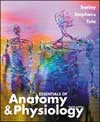 |  Essentials of Anatomy & Physiology, 4/e Rod R. Seeley,
Idaho State University
Philip Tate,
Phoenix College
Trent D. Stephens,
Idaho State University
The Reproductive System
Study OutlineFunctions of the Reproductive System(Fig. 19.1, p. 520)Male
Production of sperm cells
Sustaining and transferring sperm cells to the female
Production of male sex hormones(Table 19.1, p.529) FemaleClinical Focus: Control of Pregnancy p. 543-45
Production of female sex cells
Reception of sperm cells from the male
Nurturing and nutrition of the new individual
Production of female sex hormones(Table 19.1, p. 529) Formation of Sex Cells (Gametes)(Fig. 19.2, p. 521)Meiosis -halves genetic material Clinical Focus: Meiosis p. 522-23
Males results in 4 sperm cells
Females results in 1 secondary oöcyte
Fertilization restores full chromosome number
Male Reproductive System(Fig. 19.3, p. 523)Scrotum
Testes(Fig. 19.4, p. 524)Seminiferous tubules
Interstitial cells
Efferent ductules
Sertoli cells
Spermatogenesis
Spermatogonia
Primary spermatocytes
Secondary spermatocytes
Spermatids and sperm cells
Ducts(Fig. 19.5, p. 526)Epididymis
Ductus deferens -vas deferens
Seminal vesicle and ejaculatory duct
Urethra
Penis(Fig. 19.5, p. 526)Corpora cavernosa
Corpus spongiosum
Glans penis and external urethral orifice
Prepuce (foreskin) Glands
Seminal vesicles
Prostate gland
Bulbourethral glands
Secretions
Semen is final result
Testicular secretions
Seminal vesicle secretions
Prostatic secretions
Physiology of Male Reproduction
Regulation of sex hormone secretion(Fig. 19.6, p. 528)GnRH(Table 19.1, p. 529)FSH
LH - ICSH
Testosterone
Inhibition
Puberty
Effects of testosterone(Table 19.2, p. 530)Male sexual behavior and the male sexual act
Afferent impulses and integration
Erection, emission and ejaculation
Male infertility
Female Reproductive System(Fig. 19.7, 19.8, p. 532-33)Ovaries(Fig. 19.9, p. 531)Follicle and oöcyte development(Fig. 19.10, p. 535)Follicle development Primordial follicles
Primary follicles
Secondary follicles
Mature (Graafian) follicles
Ovary development
Primary oöcyte in prophase I
Secondary oöcyte in prophase II
Ovulation
Release of secondary oöcyte
Corpus luteum remains
Progesterone
Estrogen
Uterine tubes (fallopian tubes)Uterus
Fundus
Body
Cervix
Wall composition
Perimetrium (serous layer)Myometrium
Endometrium
Vagina and hymen
External genitalia(Fig. 19.11, p. 537)Vulva (pudendum) and vestibule
Labia minora
Clitoris
Prepuce
Vestibular glands
Labia majora
Mons pubis
Clinical perineum and episiotomy
Mammary glands(Fig. 19.12, p. 537)Development
Puberty
Sex hormone dependent
Lactation
Modified sweat glands
Milk produced by alveoli
Physiology of Female Reproduction
Puberty
Menarche
Hormonal changes precede physical changes
Menstrual cycle(Fig. 19.13, p. 539)Menses(Table 19.3, p. 540)Proliferative phase
Secretory phase
Premenstrual syndrome
Menopause(Table 19.4, p. 541)Female climacteric
Estrogen replacement therapy
Female sexual behavior and female sexual act
Excitement, secretion, orgasm, resolution
Female infertility
Endometriosis
Systems Pathology -Benign Uterine Tumors Systems Interaction Table p. 546
|
|



 2002 McGraw-Hill Higher Education
2002 McGraw-Hill Higher Education